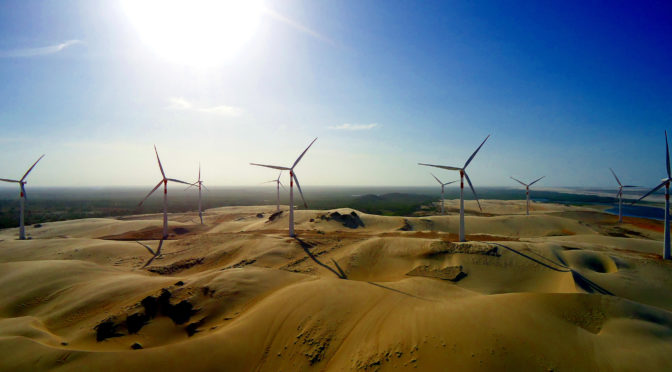The 13th edition of Brazil Windpower, the main congress and fair in Latin America on wind energy, promoted this morning the panel “Production chain and its inputs: growth and new challenges of competitiveness.”
Several wind turbine manufacturers attended the debate: Rodrigo Ugarte Ferreira, Purchasing Manager for Latam of Vestas, Roberto Veiga, General Manager of Goldwind Brazil, Felipe Ferrés, Director of Siemens Gamesa, João Paulo Gualberto da Silva, Managing Director of WEG, Marcelo Aparecido da Costa, purchasing director of Nordex and Roberto Miranda, technical director of Torres Eólicas do Nordeste (TEN).
All the debaters were unanimous in pointing out that the potential of wind energy in the country is enormous and that this demand must quadruple by 2030, given the importance that energy security has gained in recent years and the decarbonization process that the country is going through. world.
For Rodrigo Ugarte Ferreira, from Vestas, the biggest bottleneck in the sector today in Brazil is logistics. “We need a consolidated logistics chain to sell our production. But this is not what we always find, and the result is the increase in costs and the loss of competitiveness of the Brazilian industry”, explained Ferreira.
João Paulo Gualberto da Silva, from Weg, recalled that, despite the expansion of the wind energy market, wind turbine manufacturers have been reducing their production in recent decades due to the increase in raw material. On the other hand, Silva pointed out that wind energy in Brazil is already extremely competitive in relation to other energy sources.
“The Brazilian energy matrix is ??very clean. We will benefit even more in the coming years as the pressure on CO2 production increases. The low-carbon economy is irreversible and Brazilian companies must be aware of their responsibility, not only economically and environmentally, but also socially,” explained Silva.
The Weg executive pointed out that the Brazilian industry and its supply chain have a large market abroad if they improve their production processes based on low carbon emissions. For him, this will be crucial to conquer and expand exports of products made in Brazil.
The representative of Goldwind, a Chinese company that will install a factory for onshore and offshore wind turbines in Ceará, Roberto Veiga, said that it is essential that demand increases so that the production chain works better, attracting new companies to install factories in Brazil.
Veiga highlighted that the tax issue in the country continues to be an issue that needs to be discussed in order to attract more and more investment to Brazil. “The cost increases in recent years have affected the entire production chain and that reduces competitiveness. It is important that taxes are diluted throughout the production chain,” said the executive.
Siemens Gamesa executive Felipe Ferrés also expressed concern about the constant increases in the cost of production. “The supply chain cannot survive in the face of surges. Predictability is needed to execute long-term projects. The country needs to invest in expanding a base of local suppliers, encouraging production in the country, not only to meet national demand, but also with an eye on exports,” Ferrés explained.
“It is necessary to ensure competitiveness with foreign producers. This will increase local productivity, create more jobs. The era of importing everything from China is over. We have to invest in a Brazilian industrial park for the wind industry. The demand exists and we have to be prepared to supply it. A fiscal plan is fundamental to improve our competitiveness”, explained Rodrigo Ugarte Ferreira, from Vestas.
REGISTRATION
Brazil registered five new wind generation records in September, all between 5 and 7. The National Interconnected System (SIN) reached an average of 15,890 MW, which represented 22.9% of the energy demand of the SIN. The previous best result was 15,150 MW average as of August 30, 2022.
The other two best wind generation brands were in the Northeast subsystem. The snapshot reached 16,618 MW, at 22:21. The value represents 142.5% of the demand. The previous best result was 16,055 MW, measured on August 30. The new mark in the average generation of wind energy in the subsystem is 14,439 average MW, which corresponds to 136.6% of the demand.
Wind energy represents 11% of the national energy matrix, according to the Federal Government. Currently, wind farms under construction alone must add another 5.5 gigawatts to this account, with 2.95 gigawatts expected to be delivered this year.


